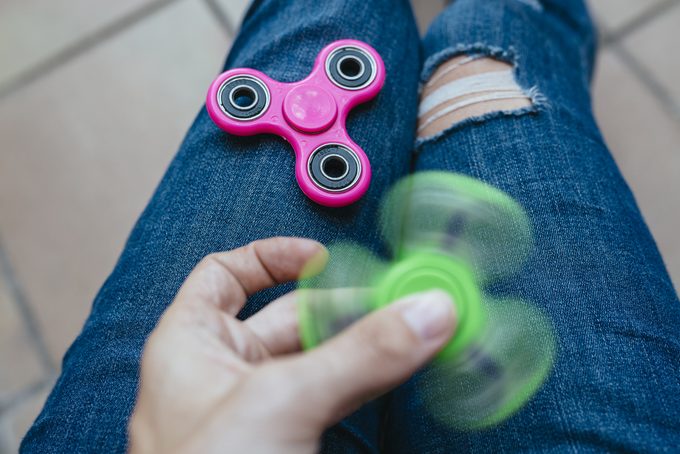Are Fidget Spinners the Best Way to Cope With Anxiety?
You’ll be surprised about what the experts have to say.

Even if you don’t have kids in your life, by now, you’ve definitely heard about fidget spinners. Fidget spinners, toys with a circular centre and various pronged designs, are said to help decrease anxiety, boost concentration and help break bad habits, like nail biting.
Fidget spinners have had their fair share of controversy due to their various pronged, sometimes-sharp design, which has been known to cause injuries. Educators are also having a hard time drawing the line between students who play with it like a toy or need it as an aid.
The health dangers of staying still
In a recent interview with CBC Radio’s Ottawa Morning, Dr. Joel Westheimer, a research chair and professor in the faculty of education at the University of Ottawa, pointed out that fidget spinners are shining a light on a much more important health issue in the classroom.
Although kids can play with fidget spinners sitting down, the trendy toy is a sign that they want to start moving more. Kids who sit most of the day are at risk of the negative effects of sitting disease. Sitting disease is associated with an increased risk of diabetes, heart disease and cancer.
“We need to look at the curriculum and make it involve more active, physically components to it,” he said.
Just as some people doodle in their notebooks during a lesson or tap their feet when they’re sitting at a desk, fidget spinners are a classroom-approved way to move around.
How moving can help you learn
Although fidget spinners are the latest trendy toy, many people identify as kinesthetic, tactile learners. You know you’re a kinesthetic learner if you retain information best when you’re participating in some form of physical activity. For example, let’s say you need to memorize something. If it’s a step-by-step process, you might write down each step onto a piece of paper. To add something tactile to the learning process, you can put each piece of paper on the floor in its correct order.
However, if stress-relief is the issue, a fidget spinners’ sharp prongs and distracting design might not the best option. Instead, a stress ball might be a better fit.
Another way to reduce stress
A study conducted by the National Dropout Prevention Center examined how stress balls would affect sixth graders learning process. The results? “All types of learners thought that their attitude, attention, writing abilities, and peer interaction improved due to stress ball use.” This was especially true for kinesthetic learners, who reported using the stress ball more consistently and having an increased attention span because of it.
While stress balls might be beneficial, there definitely needs to be more physical activity into schools’ curriculum. After all, sitting disease is real.
Canadians lack of physical activity, especially outdoor physical activity, has been an an increasing issue for all ages. No matter one’s age, we can all use more of the benefits that being outdoors brings.
If you want to move more during your workday, there are a lot of ways to do it. The next time you have a meeting with someone, suggest a walking meeting. Stretch at least every hour and make a point of taking your lunch break away from your desk. You’ll feel less stressed and anxious and feel more focused, too. No fidget spinners required.




